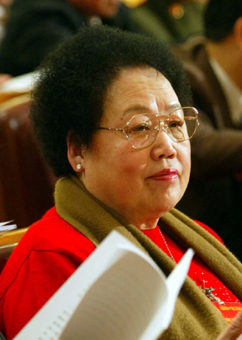
2010-09-06
 |
Madam Chan Laiwa is a renowned Chinese businesswoman. She has made the Forbes' rich list from 2001 to 2002.
Of her several multi-million-dollar ventures, she has treasured most the Chinese Red Sandalwood Museum, built with her investment of 200 million Yuan or $24 million US dollars.
It is the first and only museum of its kind dedicated to the preservation and education of the ancient Chinese art of sandalwood carving.
And the title she now prefers is curator of that museum.
Under Chan's curatorship, the museum has a fine collection of some 200 pieces of original Ming and Qing dynasty antique furniture. Meanwhile, hundreds more exhibits have also come out of the joint work of herself and her artisans.
Madam Chan has spent 30 years, as well as some of her family fortune, to collect and make the pieces. When she talks about red sandalwood, her eyes sparkle and her body brims with energy.
For her, red sandalwood is not just a hobby, it's a passion.
A descendent from an aristocratic Manchu family, Chan Laiwa developed her interest during early childhood when she would look at red sandalwood furnishings in her home and marvel at their exquisite beauty.
The history of the pieces, the ornate engravings, the delicate texture, the fragrance of the wood, the elaborate craftsmanship, and the auspicious meanings of carved motifs all would transfix her with awe and inspiration.
Red sandalwood is one of the most precious timbers on earth. It grows very slowly and is often hollow when mature. Hence the saying that "it grows an inch a century and an inch has the value of pure gold of similar size".
Yet, during the Cultural Revolution in the 60s and 70s of last century, Chan Laiwa watched as these treasures were discarded or destroyed.
Her elder brother owned some fine furniture, but the legs were sawed off and burned, broken or smashed. Another relative sold his rare dressing table for about 1 Yuan or 12.5 cents because he feared persecution.
In that tumultuous era, owning something old could be construed as a crime, or at least a sign of not supporting the revolution.
When she stood in her house, without these antique furnishings, she was filled by a sense of sadness and emptiness, as if the master of the house had left.
Chan Laiwa felt something dignified and representing the spirit of their culture was gone.
Then Chan decided to rebuild an environment of family warmth. When the revolution drew to a close, Chan started to again collect red sandalwood.
Over the years Chan opened small workshops in the suburbs of Beijing, traveling to nearby villages known for their traditional skill in carpentry to hire skilled workers.
She wanted to remake every piece of the red furniture she saw in her childhood since they embodied the centuries' old ingenuity and artistry of Chinese.
She simply didn't want that heritage to be lost.
Her passion to recreate traditional Chinese red sandalwood handicraft and her pursuit for perfection has moved curators from the Palace Museum.
Therefore, the lady and her colleagues had been allowed to look carefully at the treasures kept at the museum so that they would be able to make similar treasures out of red sandalwood.
Today, she has employed about 1,000 farmer-artisans, who come from all over the country.
She wants to share her collection with the public, and more importantly, she wants the outside world to know more about Chinese culture through this unique art form.
So she embarked on a journey to donate some of her collection to foreign countries so that people can better appreciate this culture.
A model of a sexangular pavilion that took 100 craftsmen over one year to finish was donated in early 2007 to the Kyushu National Museum in Japan.
Similar models of famous Beijing architecture have been donated to the US, the UK, Germany and France.
The next recipient of her gift will be the United Nations.
Madam Chan also takes her collection on tours around the world, including to the National Museum of Women in the Arts in Washington DC.
She even received international recognition for her dedication to reintroducing the cultural legacy of sandalwood carving.
In recent years, Madam Chan has handed over daily management of her ventures to her son, concentrating instead on museum affairs.
She has taken it as her responsibility to maintain and promote this traditional culture and pass it to the next generation.
- The Rise of China's Entrepreneurs2010-09-06
- Wu Yajun: the Newly Elected Richest Woman in China2010-09-06
- Boss Mum -- Chan Laiwa2010-09-06
- Lei Jufang Talks about Development of Tibetan Medicine2010-09-06
- Billionairesses on Forbes List2010-09-06
- Chinese Women Zhang Xin & Yan Cheung Join Billionaire Moms club2010-09-06
 xinlihawken$2.4 billion
xinlihawken$2.4 billion YangCheung$1.7 billion
YangCheung$1.7 billion Wu Yajun $3.9 billion
Wu Yajun $3.9 billion Chan LaiWa $1.1 billion
Chan LaiWa $1.1 billion LeiJuFang$1.1 billion
LeiJuFang$1.1 billion ChuLamXiu$2.1 billion
ChuLamXiu$2.1 billion